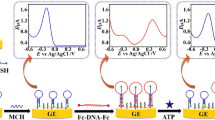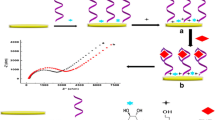Abstract
We have developed an aptasensor for adenosine triphosphate (ATP) based on an electrode-supported lipid bilayer membrane. The assay is based on a conformational change that is induced after binding the target which modulates the electron transfer rate in the conductive path. The method is highly sensitive, stable, and repeatable. The detection limit for ATP is 50 nM, and the dynamic range extends to 3.2 μM, which covers the concentration range of ATP in cell lysates (from 0.1 to 1 μM). The method also holds promise in that it may be transferred to submicro- or nano-scale electrodes so to enable intracellular monitoring of ATP.

An aptasensor for adenosine triphosphate based on an electrode-supported lipid bilayer membrane in principle of target-binding induced conformational change to modulate the electron transfer rate in the conductive path.








Similar content being viewed by others
References
Mueller P, Rudin DO, Tien HT, Wescott WC (1962) Reconstitution of cell membrane structure in vitro and its transformation into an excitable system. Nature 194:979
Knoll W, Koper I, Naumann R, Sinner EK (2008) Tethered bimolecular lipid membranes—A novel model membrane platform. Electrochim Acta 53:6680
Castellana ET, Cremer PS (2006) Solid supported lipid bilayer: from biophysical studies to sensor design. Surf Sci Rep 61:429
Bokoch MP, Devadoss A, Palencsar MS, Burgess JD (2004) Steady-state oxidation of cholesterol catalyzed by cholesterol oxidase in lipid bilayer membranes on platinum electrodes. Anal Chim Acta 519:47
Jiang D, Devadoss A, Palenscar MS (2007) Direct electrochemical evaluation of plasma membrane cholesterol in live mammalian cells. J Am Chem Soc 129:11352
Plant AL (1993) Self-assembled phospholipid/alkanethiol biomimetic bilayers on gold. Langmuir 9:2764
Plant AL, Gueguetchkeri M, Yap W (1994) Supported phospholipid/alkanethiol biomimetic membranes: insulating properties. Biophys J 67:1126
Plant AL, Brighamburke M, Petrella EC (1995) Phospholipid/alkanethiol bilayers for cell-surface receptor studies by Surface Plasmon Resonance. Anal Biochem 226:342
Plant AL (1999) Supported hybrid bilayer membranes as rugged cell membrane mimics. Langmuir 15:5128
Zwang TJ, Fletcher WR, Lane TJ, Johal MS (2010) Quantification of the layer of hydration of a supported lipid bilayer. Langmuir 26:4598
Hartshorn CM, Jewett CM, Brozik JA (2010) Molecular effects of a Nanocrystalline quartz support upon planar lipid bilayers. Langmuir 26:2609
Spurlin TA, Gewirth AA (2007) Charge dependence of a Nanoscale Supercrystal phase in a supported lipid bilayer. J Am Chem Soc 129:11906
Zhang L, Granick S (2006) Dynamical heterogeneity in supported lipid bilayers. MRS Bull 31:527
Lee KS, Won MS, Noh HB, Shim YB (2010) Triggering the redox reaction of cytochrome c on a biomimetic layer and elimination of interferences for NADH detection. Biomaterials 31:7827
Ma W, Li DW, Sutherland TC, Li Y, Long Y, Chen H (2011) Reversible redox of NADH and NAD+ at a hybrid lipid bilayer membrane using ubiquinone. J Am Chem Soc 133:12366
Ma W, Ying YL, Qin LX, Gu Z, Zhou H, Li DW, Sutherland TC, Chen Y, Long Y (2013) Investigating electron-transfer processes using a biomimetic hybrid bilayer membrane system. Nat Protoc 8:439
Christian AE, Haynes MP, Phillips MC, Rothblat GH (1997) Use of cyclodextrins for manipulating cellular cholesterol content. J Lipid Res 38:2264
Knowles JR (1980) Enzyme-catalyzed phosphoryl transfer reactions. Annu Rev Biochem 49:877
Eckford PDW, Sharom FJ (2009) ABC efflux pump-based resistance to chemotherapy. Chem Rev 109:2989
Ashcroft FM, Gribble FM (1999) ATP-sensitive K+ channels and insulin secretion: their role in health and disease. Diabetologia 42:903
Shen X, Mizuguchi G, Hamiche A, Wu C (2000) A chromatin remodelling complex involved in transcription and DNA processing. Nature 406:541
Bush KT, Keller SH, Nigam SK (2000) Genesis and reversal of the ischemic phenotype in epithelial cells. J Clin Invest 106:621
Holmsen H, Storm E, James DH (1972) Determination of ATP and ADP in blood platelets: a modification of the firefly luciferase assay for plasma. Anal Biochem 46:489
Zuo X, Song S, Zhang J, Pan D, Wang L (2007) A target-responsive electrochemical aptamer switch (TREAS) for reagentless detection of nanomolar ATP. J Am Chem Soc 129:1042
Olson F, Hunt CA, Szoka FC, Vail WJ, Papahadjopoulos D (1979) Preparation of liposomes of defined size distribution by extrusion through polycarbonate membrane. BBA Biomembr 557:9
Steel AB, Herne TM, Tarlov MJ (1998) Electrochemical quantitation of DNA immobilized on gold. Anal Chem 70:4670
Erdem A, Kerman K, Meric B, Ozsoz M (2001) Methylene blue as a novel electrochemical hybridization indicator. Electroanal 13:219
Ma C, Chen H, Han R, He H, Zeng W (2012) Fluorescence detection of adenosine triphosphate using smart probe. Anal Biochem 429:8
Zhao M, Liao L, Wu M, Lin Y, Xiao X, Nie C (2012) Double-receptor sandwich supramolecule sensing method for the determination of ATP based on uranyl-salophen complex and aptamer. Biosens Bioelectron 34:106
Jie G, Yuan J, Zhang J (2012) Quantum dots-based multifunctional dendritic superstructure for amplified electrochemiluminescence detection of ATP. Biosens Bioelectron 31:69
Zhang H, Han Y, Guo Y, Dong C (2012) Porphyrin functionalized graphene nanosheets-based electrochemical aptasensor for label-free ATP detection. J Mater Chem 22:23900
Acknowledgments
This work was supported by the Project of the National Science Foundation of People’s Republic of China (21275100), Shanghai Leading Academic Discipline Project (S30406) and Key Laboratory of Resource Chemistry of Ministry of Education.
Author information
Authors and Affiliations
Corresponding author
Electronic supplementary material
Below is the link to the electronic supplementary material.
ESM 1
(PDF 246 kb)
Rights and permissions
About this article
Cite this article
Gao, P., Xia, Y., Yang, L. et al. Aptasensor for adenosine triphosphate based on electrode–supported lipid bilayer membrane. Microchim Acta 181, 205–212 (2014). https://doi.org/10.1007/s00604-013-1100-x
Received:
Accepted:
Published:
Issue Date:
DOI: https://doi.org/10.1007/s00604-013-1100-x




